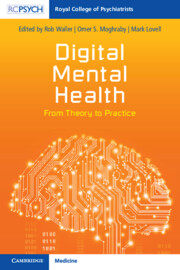Book contents
- Digital Mental Health
- Digital Mental Health
- Copyright page
- Contents
- Contributors
- Introduction
- Chapter 1 Working with IT Systems
- Chapter 2 Technology-Enabled Care
- Chapter 3 Note Keeping in the Digital Age
- Chapter 4 Big Data
- Chapter 5 Artificial Intelligence
- Chapter 6 Digital Clinicians
- Chapter 7 Global Telepsychiatry
- Chapter 8 The Integration Agenda
- Chapter 9 Digital Wellbeing
- Chapter 10 Conclusion
- Appendix: Abbreviations
- Index
- References
Chapter 1 - Working with IT Systems
The Benefits and the Challenges
Published online by Cambridge University Press: 23 November 2023
- Digital Mental Health
- Digital Mental Health
- Copyright page
- Contents
- Contributors
- Introduction
- Chapter 1 Working with IT Systems
- Chapter 2 Technology-Enabled Care
- Chapter 3 Note Keeping in the Digital Age
- Chapter 4 Big Data
- Chapter 5 Artificial Intelligence
- Chapter 6 Digital Clinicians
- Chapter 7 Global Telepsychiatry
- Chapter 8 The Integration Agenda
- Chapter 9 Digital Wellbeing
- Chapter 10 Conclusion
- Appendix: Abbreviations
- Index
- References
Summary
Self-awareness is a central characteristic of all complex systems including biological and organisational. The successful introduction of novel and complex IT systems to an organisation such as the NHS both enables, and requires, this self-awareness. IT systems promise great improvements in terms of process control, audit, governance as well as the direct delivery of clinical care. They require however that the organisation appreciates this kind of change is ‘adaptive’ as well as technical. Successful adoption requires strong, informed leadership, an honest appraisal of the degree of digital maturity, awareness of weaknesses and realism about timescales and scope. In this chapter, we will briefly survey the development of health informatics in the UK, examine some conspicuous examples of failed IT introductions and attempt to extract some lessons of use to clinicians asked to take part in such introductions. We will also survey some of the main current issues in mental health informatics from a UK perspective and make some tentative predictions for future developments.
- Type
- Chapter
- Information
- Digital Mental HealthFrom Theory to Practice, pp. 6 - 21Publisher: Cambridge University PressPrint publication year: 2023

